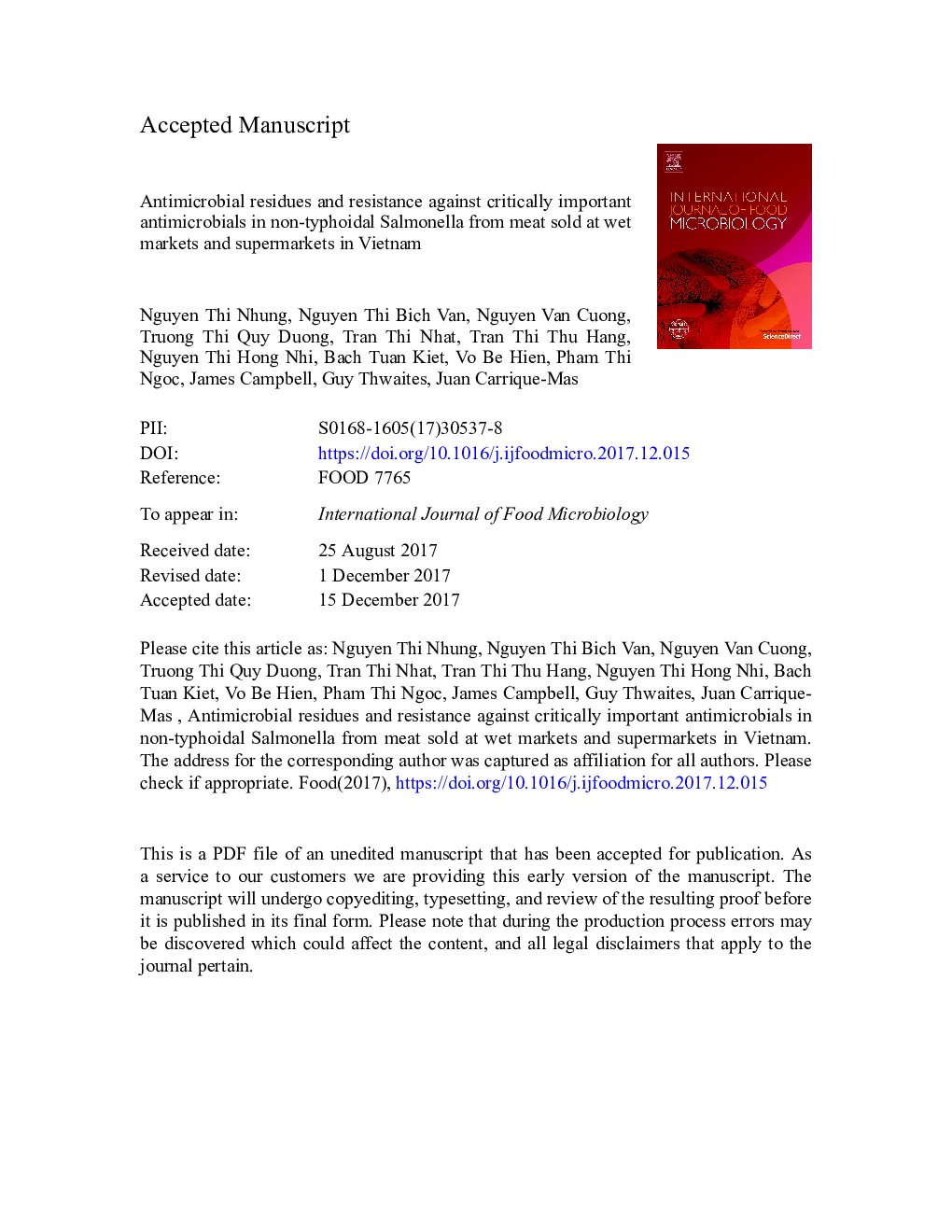| کد مقاله | کد نشریه | سال انتشار | مقاله انگلیسی | نسخه تمام متن |
|---|---|---|---|---|
| 8844339 | 1616517 | 2018 | 31 صفحه PDF | دانلود رایگان |
عنوان انگلیسی مقاله ISI
Antimicrobial residues and resistance against critically important antimicrobials in non-typhoidal Salmonella from meat sold at wet markets and supermarkets in Vietnam
ترجمه فارسی عنوان
باقی مانده های ضد میکروبی و مقاومت در برابر آنتی بیوتیک های مهم در سالمونلا غیر توفوئیدی از گوشت فروخته شده در بازارهای مرطوب و سوپرمارکت ها در ویتنام
دانلود مقاله + سفارش ترجمه
دانلود مقاله ISI انگلیسی
رایگان برای ایرانیان
کلمات کلیدی
گوشت مقاومت ضد میکروبی، باقی مانده های ضد میکروبی، سالمونلا، دامداری، مرغ،
موضوعات مرتبط
علوم زیستی و بیوفناوری
علوم کشاورزی و بیولوژیک
دانش تغذیه
چکیده انگلیسی
Excessive antimicrobial usage and deficiencies in hygiene in meat production systems may result in undesirable human health hazards, such as the presence of antimicrobial drug residues and non-typhoidal Salmonella (NTS), including antimicrobial resistant (AMR) NTS. Recently, Vietnam has witnessed the emergence of integrated intensive animal production systems, coexisting with more traditional, locally-sourced wet markets. To date no systematic studies have been carried out to compare health hazards in beef, pork and chicken in different production systems. We aimed to: (1) estimate the prevalence of antimicrobial residues in beef, pork and chicken meat; (2) investigate the prevalence and levels of NTS contamination; and (3) investigate serovar distribution and AMR against critically important antimicrobials by animal species and type of retail (wet market vs. supermarket) in Vietnam. Fresh pork, beef and chicken meat samples (N = 357) sourced from wet markets and supermarkets in Ho Chi Minh City (HCMC), Hanoi and Dong Thap were screened for antimicrobial residues by PremiTest, and were further investigated by Charm II. Samples from HCMC (N = 113) were cultured using ISO 6579:2002/Amd 1:2007. NTS bacteria were quantified using a minimum probable number (MPN) technique. NTS isolates were assigned to serovar by Multilocus Sequence Typing (MLST), and were investigated for their phenotypic susceptibility against 32 antimicrobials. A total of 26 (7.3%) samples tested positive by PremiTest (9.5% beef, 4.1% pork and 8.4% chicken meat). Sulfonamides, tetracyclines and macrolides were detected by Charm in 3.1%, 2.8% and 2.0% samples, respectively. Overall, meat samples from wet markets had a higher prevalence of residues than those from supermarkets (9.6% vs. 2.6%) (p = 0.016). NTS were isolated from 68.4% samples from HCMC. Chicken samples from wet markets had by far the highest NTS counts (median 3.2 log MPN/g). NTS isolates displayed high levels of resistance against quinolones (52.2%) and β-lactams (49.6%), but low levels against 3rd generation cephalosporins (4.4%) and aminoglycosides (0.8%). The highest adjusted prevalence of multidrug resistance (MDR) corresponded to isolates from chicken meat and pork (OR 8.3 and 1.8, respectively) (baseline = beef). S. Kentucky was the most common serovar identified (11 from chicken, 1 from beef) and 91.7% isolates was MDR. 11/12 isolates corresponded to ST198, a worldwide-disseminated multi-resistant NTS clone. We recommend stepping up policy measures to promote responsible antimicrobial use in animal production, as well as awareness about withdrawal periods to limit the hazard of residues in animal products, and improving slaughtering/hygiene procedures to limit cross-contamination with NTS, particularly in poultry wet markets.
ناشر
Database: Elsevier - ScienceDirect (ساینس دایرکت)
Journal: International Journal of Food Microbiology - Volume 266, 2 February 2018, Pages 301-309
Journal: International Journal of Food Microbiology - Volume 266, 2 February 2018, Pages 301-309
نویسندگان
Nguyen Thi Nhung, Nguyen Thi Bich Van, Nguyen Van Cuong, Truong Thi Quy Duong, Tran Thi Nhat, Tran Thi Thu Hang, Nguyen Thi Hong Nhi, Bach Tuan Kiet, Vo Be Hien, Pham Thi Ngoc, James Campbell, Guy Thwaites, Juan Carrique-Mas,
